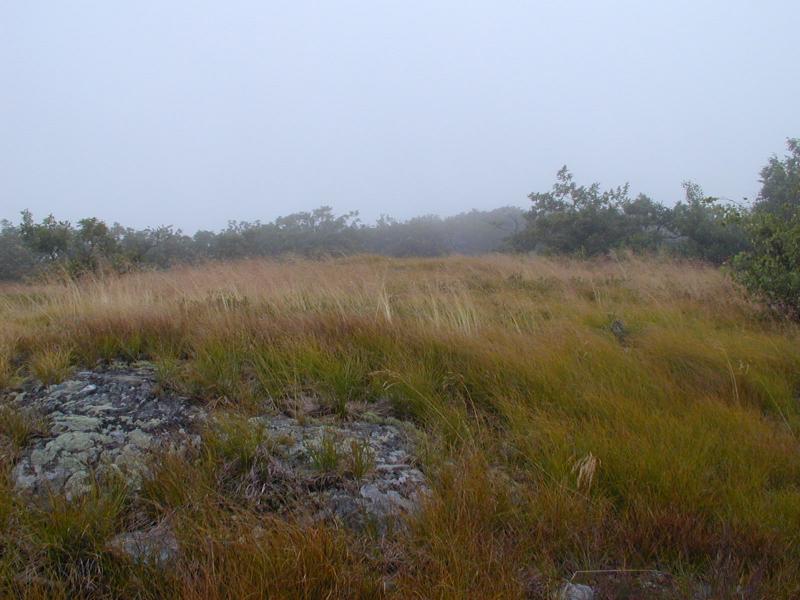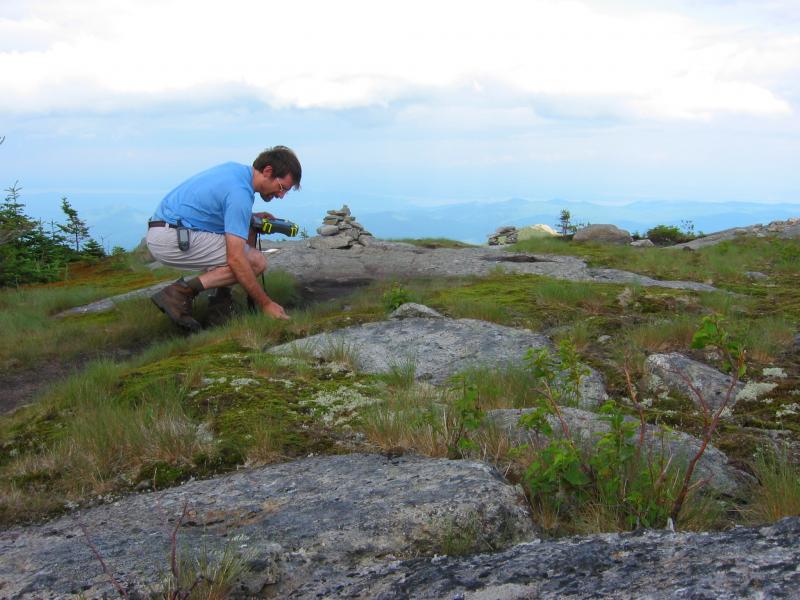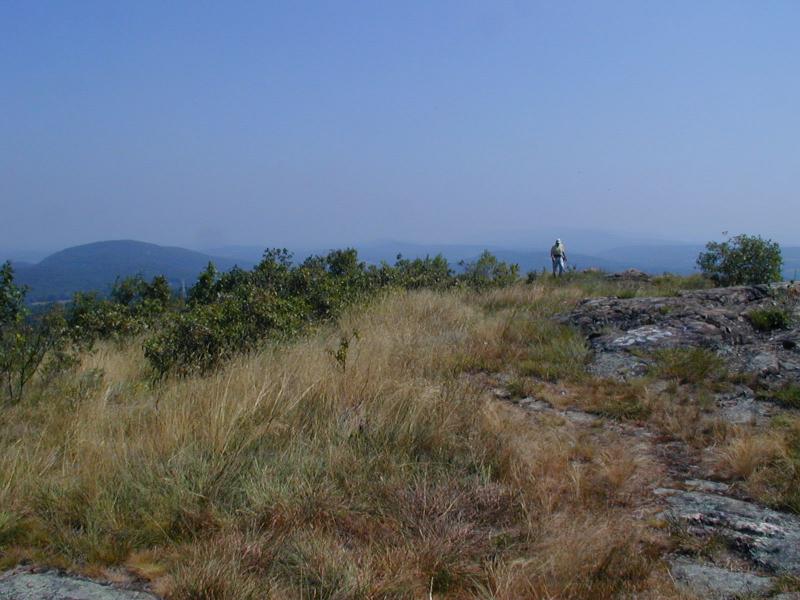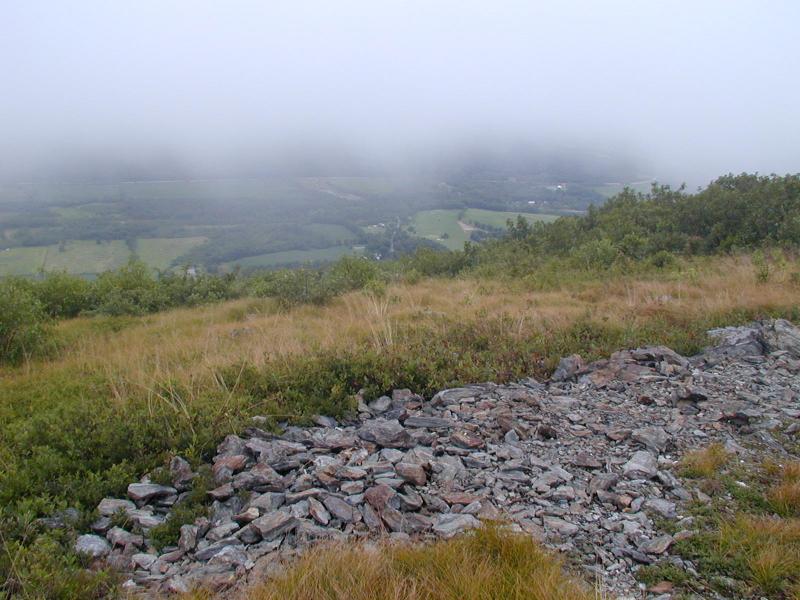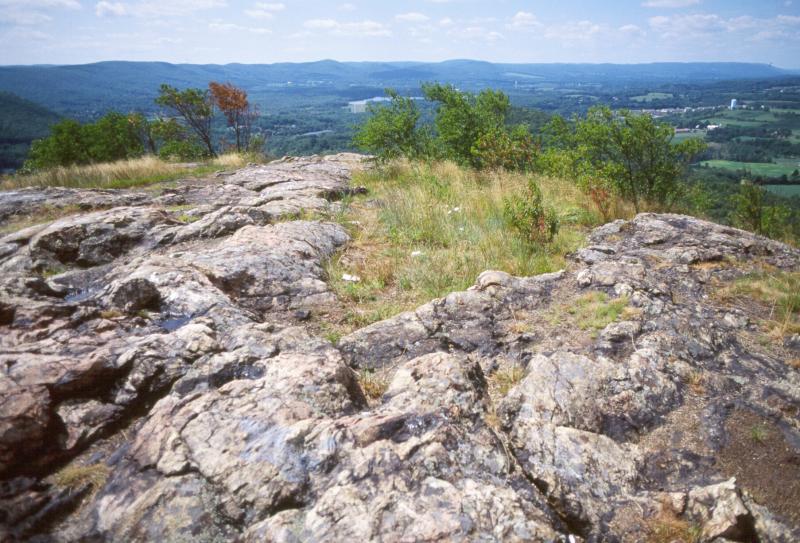Rocky Summit Grassland
- System
- Terrestrial
- Subsystem
- Open Uplands
- State Protection
- Not Listed
Not listed or protected by New York State.
- Federal Protection
- Not Listed
- State Conservation Status Rank
- S2
Imperiled in New York - Very vulnerable to disappearing from New York due to rarity or other factors; typically 6 to 20 populations or locations in New York, very few individuals, very restricted range, few remaining acres (or miles of stream), and/or steep declines.
- Global Conservation Status Rank
- G3G4
Vulnerable globally, or Apparently Secure - At moderate risk of extinction, with relatively few populations or locations in the world, few individuals, and/or restricted range; or uncommon but not rare globally; may be rare in some parts of its range; possibly some cause for long-term concern due to declines or other factors. More information is needed to assign either G3 or G4.
Summary
Did you know?
Indian grass (Sorghastrum nutans) is a common grass of some rocky summit grasslands. Indian grass roots can grow to depths of seven feet, comprising two-thirds of the grass's total biomass! Indian grass is also the host plant of common wood nymph and wood satyr butterflies. These butterflies lay their eggs on Indian grass and the caterpillars eat the grass's leaves.
State Ranking Justification
There are likely several hundred occurrences throughout upstate New York. Some of the documented occurrences have good viability and many are protected on public land or private conservation land, although most are relatively small and disturbed. This community has probably declined substantially from historical numbers and a few of the currently documented occurrences contain invasive plants and are threatened by fire suppression.
Short-term Trends
The number and acreage of rocky summit grasslands in New York have probably declined slightly in recent decades as a result of fire suppression, antenna tower construction, recreational disturbances, and invasive species.
Long-term Trends
The number and acreage of rocky summit grasslands in New York have probably declined substantially from historical numbers as a result of fire suppression.
Conservation and Management
Threats
Invasive plants and fire suppression are the top two threats to rocky summit grasslands. Natural fire regimes (i.e., fires started through lightning strikes) appear suppressed at several sites resulting in woody plant invasion. Invasive plants, such as Japanese Angelica tree (Aralia elata), old world reed grass (Phragmites australis), black swallowwort (Vincetoxicum nigrum), tree of heaven (Ailanthus altissima), spotted knapweed (Centaurea stoebe ssp. micranthos), bluegrass (Poa compressa), and sheep sorrel (Rumex acetosella), are a threat at several rocky summit grasslands. A few rocky summit grasslands are threatened by development within the community (especially plans for cellular telephone and radio towers, wind farms, and logging roads) and in the surrounding landscape. Popular sites with scenic views are threatened by trampling by recreational visitors (e.g., mountain bikers, hikers, trash, graffiti). Over-browsing by deer of characteristic rocky summit grassland plants may be perceived as a minor threat at a few sites by reducing or eliminating characteristic native plants, but may benefit the community by helping maintain the open structure.
Conservation Strategies and Management Practices
Management activities should include the development and implementation of prescribed burn plans at appropriate sites. Fragmenting features such as roads, abandoned tower clearings, and unnecessary trails should be reduced or minimized, and high-impact activities such as mountain biking and hang-gliding should be restricted to trails and least sensitive areas. Prevent the dumping of trash.
Development and Mitigation Considerations
Soils are very thin in and around this community and the effect of clearing and construction on soil retention and erosion must be considered during any development activities. Similarly, these soils are acidic and nutrient-poor and any soil enrichment contamination (e.g., from septic leach fields and fertilized lawns) may alter alter community structure and function. The open structure of this community is maintained by fire and presents a fire hazard to existing and proposed development. Unprotected structures located within or near this community are more susceptible to damage from fire.
Inventory Needs
Survey for occurrences statewide to advance documentation and classification of rocky summit grasslands. A statewide review of rocky summit grasslands is desirable. Continue searching for large sites in good condition (A- to AB-ranked).
Research Needs
Research the composition of rocky summit grasslands statewide in order to characterize variations (e.g., identify those dominated by different grass species). Collect sufficient plot data to support the recognition of several distinct rocky summit grasslands based on ecoregion, geology, and dominant grass species.
Rare Species
- Asclepias viridiflora (Green Milkweed) (guide)
- Carex bicknellii (Bicknell's Sedge) (guide)
- Carex cumulata (Clustered Sedge) (guide)
- Carex merritt-fernaldii (Fernald's Sedge) (guide)
- Carex mesochorea (Midland Sedge) (guide)
- Carex retroflexa (Reflexed Sedge) (guide)
- Carex tincta (Tinged Sedge) (guide)
- Crotalus horridus (Timber Rattlesnake) (guide)
- Desmodium ciliare (Hairy Small-leaved Tick Trefoil) (guide)
- Eurybia spectabilis (Showy Aster) (guide)
- Houstonia purpurea var. calycosa (Midwestern Purple Bluets) (guide)
- Myotis septentrionalis (Northern Long-eared Bat) (guide)
- Neotoma magister (Allegheny Woodrat) (guide)
- Pycnanthemum clinopodioides (Basil Mountain Mint) (guide)
- Ranunculus micranthus (Small-flowered Buttercup) (guide)
- Sceloporus undulatus (Fence Lizard) (guide)
- Solidago racemosa (Riverbank Goldenrod) (guide)
- Solidago rigida var. rigida (Stiff Flat-topped Goldenrod) (guide)
Range
New York State Distribution
This community is widespread throughout upstate New York, north of the North Atlantic Coast Ecoregion. Rocky summit grasslands are more common in the southern and eastern parts of this range and are probably represented by different regional variants. This community is concentrated in the Lower New England Ecoregion within the Hudson Highlands, but it is also known from the Taconic Mountains, the Adirondack Mountains, the St. Lawrence and Lake Champlain Valley, and possibly the western part of the state.
Global Distribution
The range of the broadly-defined community is probably global. Examples with the greatest biotic affinities to New York occurrences are suspected to be widespread throughout the mountainous areas of the Appalachian Range. Occurrences are suspected of being concentrated near the middle of this range. This range is estimated to span north to southern Canada, west to Ohio and Kentucky, south to Alabama and Georgia, and southeast to New Jersey.
Best Places to See
- Adirondack Park
- High Tor State Park (Rockland County)
- Bear Mountain State Park (Orange County)
- Taconic State Park
- Hudson Highlands State Park (Westchester County)
- South Mountain County Park, Gurnee County Park (Rockland County)
Identification Comments
General Description
A grassland community that occurs on rocky summits, ridges, and exposed outcrops. The vegetation is dominated by herbaceous plants, especially grasses. Woody species, such as red oak (Quercus rubra) and lowbush blueberry (Vaccinium pallidum, V. angustifolium), are sparse, and may be present near the community margins (Edinger et al. 2002).
Characters Most Useful for Identification
Rocky summit grasslands occur on rocky outcrops and summits with thin soils, and are dominated by grass species such as little bluestem (Schizachyrium scoparium), tufted hairgrass (Deschampsia flexuosa), poverty-grass (Danthonia spicata, D. compressa), and Indian grass (Sorghastrum nutans). Also common are Pennsylvania sedge (Carex pensylvanica), ebony spleenwort (Asplenium platyneuron), and fragrant goldenrod (Solidago odora).
Elevation Range
Known examples of this community have been found at elevations between 10 feet and 4,365 feet.
Best Time to See
Many of the grasses and forbs characteristic of this community, such as little bluestem and goldenrod, come into maturity in late summer.
Rocky Summit Grassland Images
Classification
International Vegetation Classification Associations
This New York natural community encompasses all or part of the concept of the following International Vegetation Classification (IVC) natural community associations. These are often described at finer resolution than New York's natural communities. The IVC is developed and maintained by NatureServe.
- Little Bluestem - Poverty Oatgrass - Pennsylvania Sedge / Cup Lichen species Grassland (CEGL006544)
NatureServe Ecological Systems
This New York natural community falls into the following ecological system(s). Ecological systems are often described at a coarser resolution than New York's natural communities and tend to represent clusters of associations found in similar environments. The ecological systems project is developed and maintained by NatureServe.
- Central Appalachian Pine-Oak Rocky Woodland (CES202.600)
Characteristic Species
-
Trees > 5m
- Carya glabra (pignut hickory)
- Juniperus virginiana var. virginiana (eastern red cedar)
- Prunus serotina var. serotina (wild black cherry)
- Quercus alba (white oak)
- Quercus montana (chestnut oak)
- Quercus rubra (northern red oak)
-
Shrubs 2 - 5m
- Pinus strobus (white pine)
- Viburnum prunifolium (black-haw)
-
Shrubs < 2m
- Comptonia peregrina (sweet-fern)
- Gaylussacia baccata (black huckleberry)
- Vaccinium angustifolium (common lowbush blueberry)
- Vaccinium pallidum (hillside blueberry)
-
Herbs
- Andropogon gerardi (big bluestem)
- Asplenium platyneuron (ebony spleenwort)
- Avenella flexuosa (common hair grass)
- Carex pensylvanica (Pennsylvania sedge)
- Danthonia spicata (poverty grass)
- Dichanthelium acuminatum
- Dichanthelium clandestinum (deer-tongue rosette grass)
- Lysimachia quadrifolia (whorled-loosestrife)
- Rumex acetosella
- Schizachyrium scoparium var. scoparium (little bluestem)
- Solidago odora (sweet goldenrod)
- Solidago puberula (downy goldenrod)
- Sorghastrum nutans (Indian grass)
- Verbascum thapsus (common mullein)
-
Nonvascular plants
- Polytrichum commune
Similar Ecological Communities
- Dry alvar grassland
(guide)
Dry alvar grasslands occur on shallow soils over level outcrops of calcareous bedrock. In New York, they are only known from a few locations in Jefferson county. The vegetation is made up of calciphilic graminoids and forbs, most of which are not characteristic of rocky summit grasslands.
- Open alpine community
(guide)
The open alpine community occurs above treeline on high mountain summits over 1,620 m (4,900 feet). Rocky summit grasslands are located at lower elevations, at sites with exposed bedrock and thin soils.
- Red cedar rocky summit
(guide)
Red cedar rocky summit communities have species compositions and environmental settings that are similar to rocky summit grasslands, but the physiogonomic structure differs. Red cedar rocky summits have denser woody vegetation, particularly eastern red cedar and heath species, than rocky summit grasslands.
- Serpentine barrens
(guide)
Serpentine barrens are a grass-savanna community that only occurs on shallow soils over serpentine bedrock. In New York, this community is only known from Staten Island.
- Successional northern sandplain grassland
(guide)
While these communities may share similar species, successional northern sandplain grasslands occur on sandy soil and are dominated by bluestem (Schizachyrium scoparium), hairgrass (Avenella flexuosa), Pennsylvania sedge (Carex pensylvanica), poverty grass (Danthonia spicata), and panic grasses (Dichanthelium spp.). Rocky summit grasslands occur on rocky summits and exposed rocky slopes of hills and are dominated by bluestem (Schizachyrium scoparium), tufted hairgrasss (Avenella flexuosa), poverty-grass (Danthonia spicata, D. compressa), and Indian grass (Sorghastrum nutans).
- Successional old field
Successional old fields are sites that have been cleared (and possibly plowed) for agricultural purposes, then have been abandoned. They may feature a large variety of herbaceous and shrubby species, and are not associated with summits, ridges, or exposed bedrock.
Vegetation
Percent cover
This figure helps visualize the structure and "look" or "feel" of a typical Rocky Summit Grassland. Each bar represents the amount of "coverage" for all the species growing at that height. Because layers overlap (shrubs may grow under trees, for example), the shaded regions can add up to more than 100%.
Additional Resources
References
Edinger, G. J., D. J. Evans, S. Gebauer, T. G. Howard, D. M. Hunt, and A. M. Olivero (editors). 2014. Ecological Communities of New York State. Second Edition. A revised and expanded edition of Carol Reschke’s Ecological Communities of New York State. New York Natural Heritage Program, New York State Department of Environmental Conservation, Albany, NY. https://www.nynhp.org/ecological-communities/
Edinger, Gregory J., D.J. Evans, Shane Gebauer, Timothy G. Howard, David M. Hunt, and Adele M. Olivero (editors). 2002. Ecological Communities of New York State. Second Edition. A revised and expanded edition of Carol Reschke's Ecological Communities of New York State. (Draft for review). New York Natural Heritage Program, New York State Department of Environmental Conservation. Albany, NY. 136 pp.
Fike, J. 1999. Terrestrial and Palustrine Plant Communities of Pennsylvania. Pennsylvania Natural Diversity Inventory, Harrisburg, PA.
Mark, A. F. 1959. The flora of the grass balds and fields of the southern Appalachian Mountains. Castanea 24:1-21.
Mark, A.F. 1958. The ecology of the southern Appalachian grass balds. Ecol. Monogr. 28: 293-336.
New York Natural Heritage Program. 2024. New York Natural Heritage Program Databases. Albany, NY.
Rentch, J.S. and R.H. Fortney. 1997. The vegetation of West Virginia grass bald communities. Castanea 62(3):147-160.
Reschke, Carol. 1990. Ecological communities of New York State. New York Natural Heritage Program, New York State Department of Environmental Conservation. Latham, NY. 96 pp. plus xi.
Ring, Richard M. 2018. Rocky Summit Grassland Natural Communities in New York State Parks: Vegetative Ecology, Rare Plants, and Management Recommendations. New York Natural Heritage Program and New York State Office of Parks, Recreation and Historical Preservation, Albany NY.
Swain, P. C., and J. B. Kearsley. 2001. Classification of natural communities of Massachusetts. September 2001 draft. Natural Heritage and Endangered Species Program, Massachusetts Division of Fisheries and Wildlife, Westborough, MA.
Wiegl, P. D., and T. W. Knowles. 1999. Antiquity of Southern Appalachian grass balds: The role of keystone megaherbivores. Pages 215-223 in: R. P. Eckerlin, editor. Proceedings of the Appalachian Biogeography Symposium, Virginia Museum of Natural History Special Publication Number 7.
Links
About This Guide
This guide was authored by: Timothy G. Howard
Information for this guide was last updated on: November 13, 2023
Please cite this page as:
New York Natural Heritage Program. 2024.
Online Conservation Guide for
Rocky summit grassland.
Available from: https://guides.nynhp.org/rocky-summit-grassland/.
Accessed July 26, 2024.
